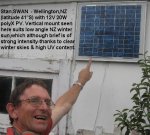Re coils, inductors may be an option though most are wound so as to contain the magnetic flux (eg potcores). There are some that are wound on a ferrite rod though. You will need to decide if you want an iron core or not. The iron greatly amplifies the output, but the downside is cogging. If you don't use iron, you need the coil wound such a way that one side of the coil is close to the magnet and the other side is some distance away - otherwise the flux gets cancelled out. That implies a big(ish) coil - maybe 3-5cm in diameter.
Hugh Piggott is an expert on this sort of thing - winding coils yourself, potting them in epoxy, gluing magnets and potting them etc.
What sort of size generator are you building? This started as a computer fan, but I think it grew into something with 30cm blades on it? Anytime you add blades on, you greatly increase the forces on the bearings in high wind. It may be better to start by defining the diameter of the blades, and then selecting a bearing that can cope with the load, then work out the pitch of the blades, and then work out the RPMs, and then work out the best coil/magnet design for that RPM. You may find that steers you towards a motor of a particular design, but bear in mind that most motors have bearings that are designed for radial loads (ie loads out sideways), and for a turbine you have loads coming from the front. That implies thrust bearings. Steppers, and hobby motors do not have thrust bearings. A computer fan does (sort of), but it can only handle grams of force, and you will overload the bearings if you glue bigger blades on. Actually, not many things have thrust bearings. A cordless drill does. And the bearing from a car or trailer does. Oops, suddenly this has increased in scale! It is no accident though that Hugh Piggott uses the assembly from a car wheel - you get a thrust bearing and you also get the brake as well.
There are some cost/benefit equations here as well. Wind starts to work at diameters of 1 metre or more. Below that size, you still have to build lots of complicated stuff, but you get less and less power. At power levels of under 10 watts, I think solar may be simpler and more cost effective.



